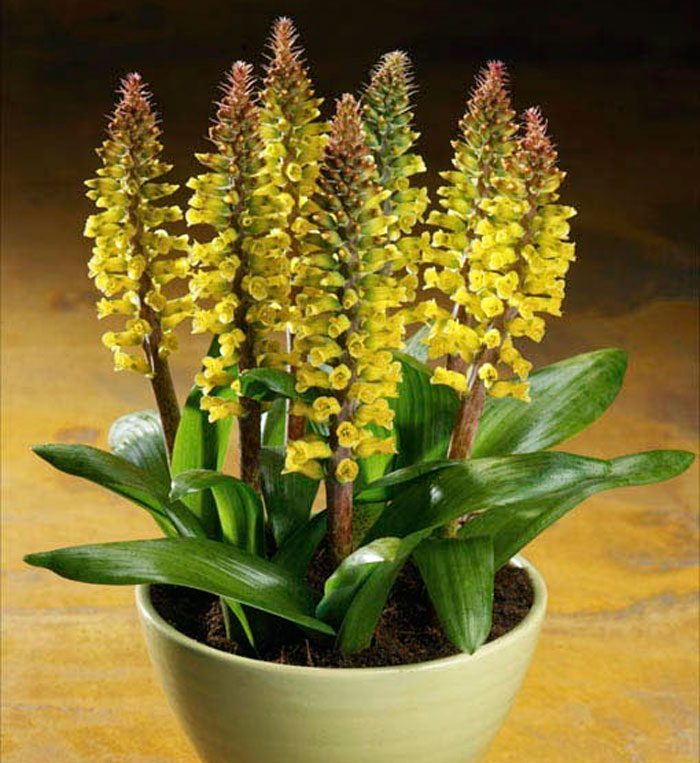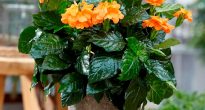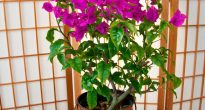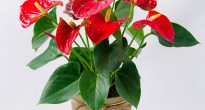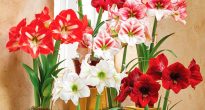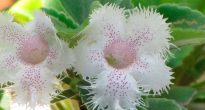Genus of plants lashenalia belongs to the hyacinth family. These plants come from South Africa. There are more than 100 species.
Lachenalia aloe Lachenalia aloides is most popular with flower growers. This potted flower has long leaves, collected in a rosette, which have a belt-like or lanceolate shape and reach about 20 centimeters in length. The leaves are colored dark green, and there are small brownish spots on their surface. Intensely colored multi-flowered inflorescences rise on long peduncles (up to 30 centimeters long), collected in a brush. Three-centimeter drooping greenish-yellow flowers have light red specks on their surface. Flowering is observed in winter. There are varieties in which the flowers are colored green, deep red or olive.
Content
Lashenalia care at home
Such a flower is not suitable for growing by beginner growers. He needs special conditions for normal growth and development. Also, a cool rest period is required for him. It must be watered very carefully to prevent waterlogging of the soil. Also, this plant reacts extremely negatively to stale air and smoke from cigarettes. The room where it is located must be ventilated quite often.
Temperature regime
A moderate temperature is recommended in spring and summer. The plant does not tolerate hot weather. When it is hot outside and the air is too dry (prolonged absence of rain), and if the temperature remains at 28 degrees, then you need to very often ventilate the room or even take the lashenalia out onto the balcony, shading it from the sun's rays. In winter, it is recommended to move it to a rather cool place (12 degrees). Make sure that in the cold season the temperature in the room is at least 6 degrees.
Illumination
Loves light very much. The flower needs bright lighting, but the light should be diffused. A small amount of direct sunlight is allowed in the morning and evening hours. It is recommended to place it on the east or northwest orientation window. On the windowsill of the south window it can grow only with shade from the sun's rays.
How to water
In winter, watering should be moderate. During the flowering period, the plant must be watered after the top layer of the substrate dries out. During the cold dormant period, watering is stopped altogether. The plant reacts equally negatively to overdrying and waterlogging of the substrate.
Top dressing
During the formation of buds, as well as flowering, lashenalia must be fed once a week. A complex fertilizer for decorative flowering plants is suitable for this, while using ½ or 1/3 of the dosage recommended on the package (NPK ratio - in equal parts). Reacts negatively to a large amount of salts in the soil.
Humidity
The flower needs regular moistening from a spray bottle. The surface of the leaves must be systematically wiped with a damp sponge.
Transplant features
Transplanted once a year in autumn. The soil mixture consists of leaf, turf and peat soil, as well as sand. For planting, you need to choose a fairly compact pot. To obtain a lush bush, 7 or 8 bulbs are planted simultaneously in a container with a fifteen-centimeter diameter. In this case, the bulbs must be completely covered with soil. In order to avoid the appearance of rot on the bulbs, it is required to make the upper drainage. To do this, the onion is buried ½ part in the soil mixture, and drainage is poured on top, which can consist of gravel or washed expanded clay.
Reproduction methods
During transplantation, the daughter bulbs can be separated. They are planted in autumn, buried in the soil by one and a half or two centimeters. Such lashenalia begin to bloom in the 2nd year of life. The plant grown from seeds blooms for the first time in the 3rd year of life. For seeding, use a wide and low container filled with coarse sand. They are buried in the soil by 2 or 3 millimeters.

